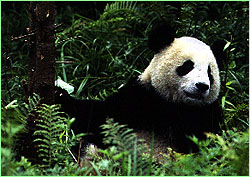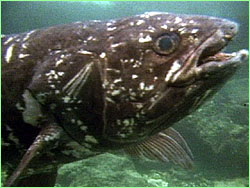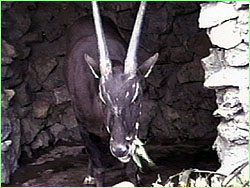 |
 |
 |
Part 3 | back to part 2 Just because it hasn't been seen in a long time doesn't mean it doesn't exist. In 1869, the French missionary Armand David became the first Westerner to lay eyes on a giant panda, when Chinese hunters brought him a young panda they had killed. David never saw a live panda, and in the ensuing decades, as expedition after expedition failed to turn up the animal, people in the West began to wonder whether the purported black-and-white "bear" even existed. A German expedition to southeast Tibet finally saw one in 1915, but it was not until 1929, when two sons of Theodore Roosevelt shot one in China and placed its stuffed skin in Chicago's Field Museum, that the giant panda finally came into being for many. Even when scientists have specimens in hand, they may remain fantastic. One of the most famous of the sea serpents in days of yore was the kraken, from the Norwegian word denoting a tree trunk with its roots. Alfred, Lord Tennyson once described the kraken's many arms: And far away into the sickly light,
Sometimes animals thought long extinct turn up alive. The idea that Nessie might be a surviving marine reptile of the Age of Dinosaurs is not as far-fetched a notion as many might believe. The five-foot-long fish known as the coelacanth was thought to have died out a full 25 million years before the dinosaurs vanished, until a fisherman caught one off the African coast in 1938. (The coelacanth has recently turned up in Indonesian waters as well.) Long-lost creatures are still found on land, too. In 1995, the French ethnographer Michel Peissel discovered what appears to be an ancient breed of horse in a remote valley of northeastern Tibet. The Riwoche horse, as his team named the animal for its home region, looks just like horses in cave paintings of the European Stone Age. If an ancient horse can be found in a remote Tibetan valley, is it possible that the fabled giant sloth might one day be found in the remote Amazonian jungle? Despite common wisdom, the world has not been fully explored. In 1812, the renowned French naturalist Baron Georges Cuvier boldly asserted that "there is little hope of discovering new species of large quadrupeds." Wrong. A short list of large mammals that have been identified since 1812 might include, in addition to all those mentioned above, the mountain gorilla, Indian tapir, black ape, siamang, gelada, Himalayan takin, Père David's deer, Przewalski's horse, white rhinoceros, pygmy chimpanzee, and Kodiak brown bear.
The great 19th-century American naturalist Louis Agassiz once held that "[e]ach time that a new and surprising fact is revealed by science, people say first that 'it is not true,' then, that it 'disagrees with religion,' and, finally, that 'everyone has always known it.'" Those who hold no truck with notions of Nessie or Sasquatch or the Abominable Snowman may do well to consider these words, just as they may do well to remember the story of that fantastic antelope-donkey-anteater-giraffe, the okapi. Peter Tyson is Online Producer of NOVA. Photos: (1) Mark Dell'Aquila; (2,6,10) Wildlife Conservation Society; (3) VU/Science VU; (4,9) VU/Ken Lucas; (5) VU/Gerald and Buff Corsi; (7) BBC. Fantastic Creatures | Birth of a Legend Eyewitness Accounts | Experimenting with Sonar Resources | Transcript | Site Map | Loch Ness Home Editor's Picks | Previous Sites | Join Us/E-mail | TV/Web Schedule About NOVA | Teachers | Site Map | Shop | Jobs | Search | To print PBS Online | NOVA Online | WGBH © | Updated November 2000 |
 It took a specimen shot
in China by sons of Teddy Roosevelt to finally convince outsiders that the
giant panda actually existed.
It took a specimen shot
in China by sons of Teddy Roosevelt to finally convince outsiders that the
giant panda actually existed.
 Before a fisherman caught one in 1938 off the Comoros Islands, the
coelacanth was thought to have been extinct for 90 million years.
Before a fisherman caught one in 1938 off the Comoros Islands, the
coelacanth was thought to have been extinct for 90 million years.
 Every large animal on Earth has already been discovered? Hardly. The pseudo
oryx was only identified in the 1990s.
Every large animal on Earth has already been discovered? Hardly. The pseudo
oryx was only identified in the 1990s.